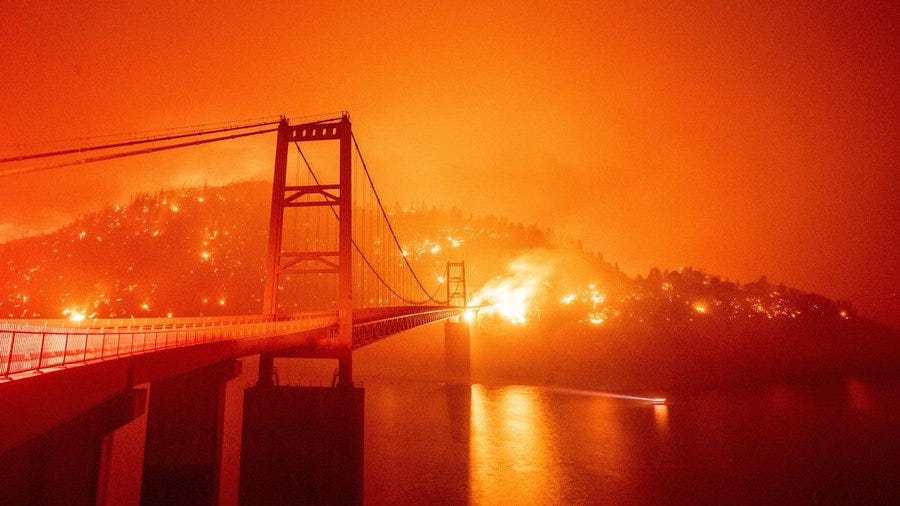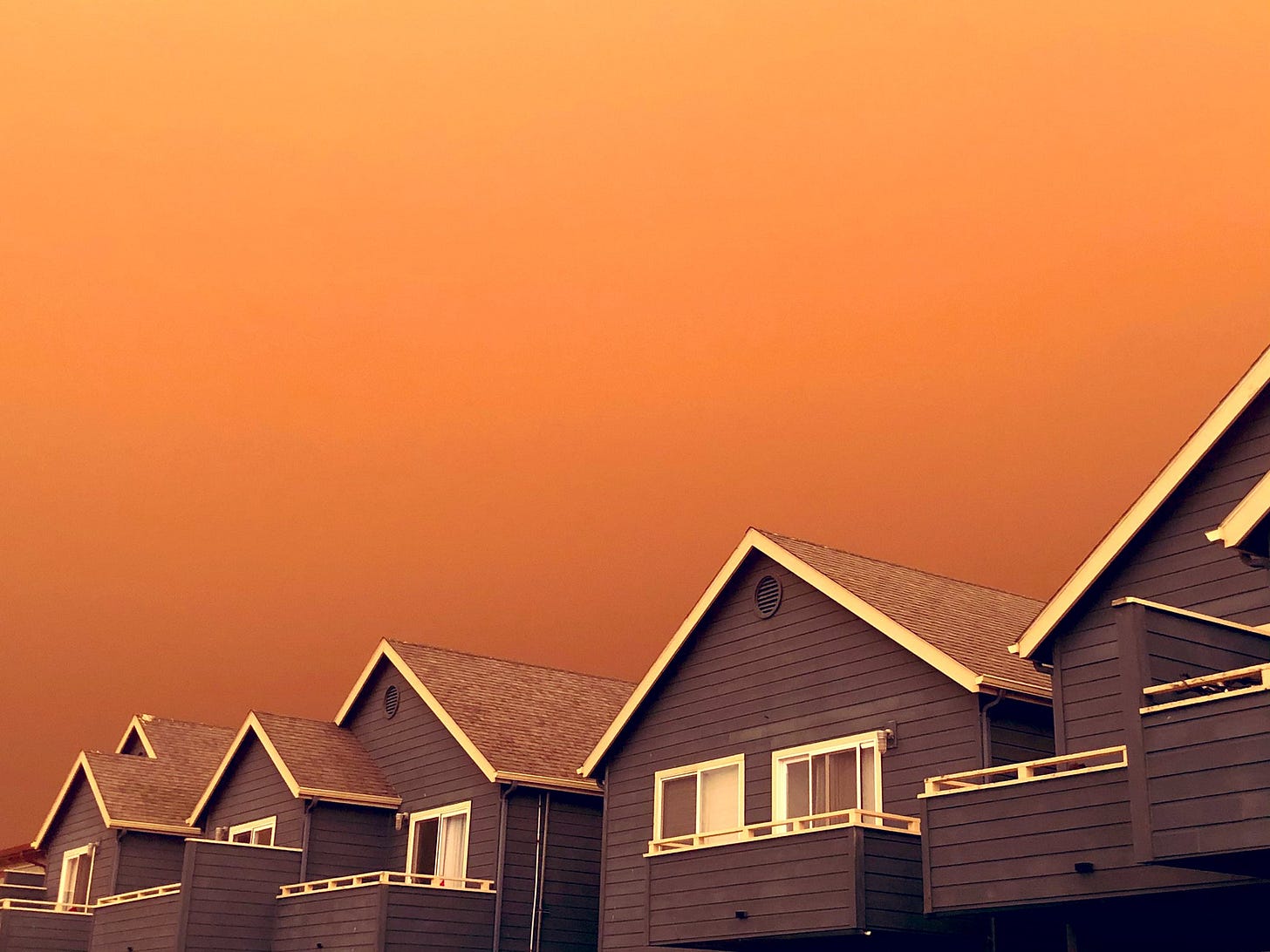
If you doomscroll through Twitter like me, chances are your timeline has been inundated with images of wildfires spreading across California and the Pacific Northwest. More specifically, pictures and videos of an eerie sky flooded the internet. As plumes of smoke covered the sun, the sky illuminated with deep hues of orange and red from morning to night. Images of the orange sky capture an apocalyptic phenomenon that resemble a scene somewhere in between the landscape of Mars and the pits of fiery hell.
Despite the public health hazards, property destruction, and displacement the wildfires are causing, there is an undeniable allure to the smolder-filled sky. The wildfires created its own visual culture, a once in a lifetime array of colors that West Coast observers have documented. Orange sky images emulate real-life sets from movies such as Blade Runner 2049 and Constantine. Some of the images mirror posts you’d see on a minimalist Instagram page run by art hoes, and others render the skies as a backdrop amid everyday activity. Couples are even taking wildfire wedding photos, dressed in traditional marriage garb and face masks to protect their lungs from smoke.
As I scroll through dozens of sky images taken from every geographic vantage point on the West Coast, I find myself both horrified and captivated by the visual impacts of the wildfires. A pang of guilt sweeps over me as I gaze at the orange sky images in awe. Nonetheless, I can’t help but wonder: Does climate change and environmental destruction have their own aesthetic? And if so, why is it so visually appealing?

In Open Space magazine, the Rebar Art and Design studio — a San Francisco based collective operating at the nexus of art, design, and activism — attempts to answer this question in their article “The aesthetics of ecological (dys)function.”
“But what is it exactly that fascinates or repulses us about beautiful images of environmental destruction?” Rebar asks. “I’m wondering if it's the cognitive dissonance between what we see in the picture: beautiful shapes or colors and what we know about the underlying processes that generates the image – environmental destruction. “My sense is that humans have not yet developed a sophisticated enough visual language to be able to decode or discern the difference between beauty and ecological dysfunction.”
Essentially, Rebar theorizes that there is a disconnect between what we see and its underlying context, and that humans are unable to comprehend both when confronted with ecological dysfunction imagery. The orange sky depicts the impacts of forests engulfed in flames, but it’s difficult to internalize its magnitude when our brain registers it as a never ending sunset. Since there is no point of reference to an unprecedented environmental phenomenon like an orange sky, we compare it to art that contains a similar color gradient. No wonder people are snapping smiley selfies under a hazy orange glow, and are adding the orange sky to their bucket list of must-see natural wonders. We are cognitively incapable of parsing beauty from disaster.

Entertainment and mass media that center environmental collapse may also play a role in cultivating an aesthetic paradox. Documentaries like Chasing Ice and Meru, for example, include high-resolution footage of environmental phenomena like melting icebergs and avalanches, dramatizing it by adding tense instrumental music and narration with a serious tone. The sci-fi apocalypse genre also amplifies the aesthetic. Disaster movies like The Knowing and 2012 render environmental catastrophe as the main source of conflict through CGI and special effects. Whether it’s a solar flare that converts flesh into dust, or a 10.9 magnitude earthquake that splits open the ground, entertainment producers represent environmental disaster as both terrifying and visually stimulating.
In other words, stylized and fictional depictions of environmental destruction may have broken our brains into thinking that natural disasters possess aesthetic value.
Maybe I am a sociopath for deriving visual pleasure from the ecological collapse of our own creation. However, this is a common feeling among curious observers on social media. Twitter and Instagram users are reacting to images of the orange sky with a similar ambivalence, sparking discourse in the comment sections over the ethics of calling an environmental disaster beautiful.


In case anyone is disgusted by my aesthetic analysis on the orange sky, I want to emphasize that there is nothing inherently beautiful about the wildfires. Sudden temperatures spikes and dangerous air quality loom over the West Coast as a result, which may contribute to respiratory and cardiovascular problems. People of color are especially at-risk since they live in areas exposed to high levels of particulate matter. In addition, the wildfires are not isolated events on the West Coast, but are also wreaking havoc in Brazil, Greece, Bulgaria and Argentina. The wildfires’ impact on public health and marginalized communities around the world cannot be understated through striking images of the sky.
If there is one takeaway from the spectacle of the orange sky, it is that we are living in a climate emergency that is pulverizing the natural world in real-time. An orange sky may become a daily lived reality for all of us if our current economic system dependent on extractivism is not upended and reimagined. A sherbert colored atmosphere is not something to look forward to, even if that means a once-in-a-lifetime selfie opportunity, or a market for prints of environmental destruction.
Therefore, if photographers are going to use digital media as a platform for spreading environmental awareness, new forms of visual representation must be enacted to bridge the cognitive dissonance between aesthetics and context. Media creators have a responsibility to capture the world in a way that reflects the complex reality of climate change without reducing them to eye candy. I don’t know what that looks like in practice. However, the least we can do is to spend less time fawning over the beauty of the orange sky, and more time understanding the political, economic, environmental, and social context behind these images.
Maybe pictures aren’t worth more than 1000 words after all.





